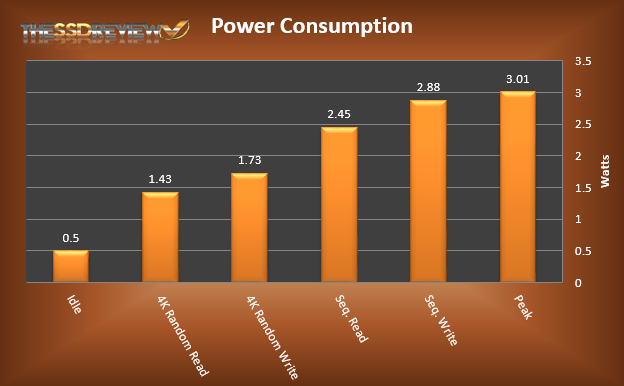POWER CONSUMPTION
For our power consumption testing, we have the drive connected to the system as a secondary drive. To record the wattage, we use an Amprobe AM-270 multimeter connected in line with the 5v power on our SATA power cable to the drive. The multimeter records the min/max amperage draw from the drive over our testing period. We also record the drive’s sequential and random read and write power draw using Anvil Storage Utilities. We then take the values recorded and calculate the wattage of the drive. Some of the results may seem high compared to a standard notebook HDD because as these are peak values under load. When we see average power draw, SSDs are still more power efficient because they only hit max power for a short period of time.
The 240GB SanDisk Ultra II is rated for a max read power draw of 2.7W and a max write power draw of 4.5W. It is also rated for a slumber power draw of 75mW for the 120GB and 240GB drives and 85mW draw for the 480GB and 960GB drives. As per our testing results, our drive was able to stay well within the maximum range. From our testing we can see 4K read and write consumption was 1.43W and 1.73W respectively. Idle power draw was also decent at 0.5W. Finally, sequential writes are the power leech, which is typical for most SSDs.
REPORT ANALYSIS
Throughout our testing, the 240GB SanDisk Ultra II has performed well. It was able to easily hit rated speeds and perform decently in our consistency testing overall. I even did a little more testing after our typical benchmarks just to see how much the drive’s speed dropped once the SLC cache buffer ran out. In testing, after around 8-10GB of data transfer, write speeds dropped to around 240MB/s. This is still pretty good, especially considering it is such a compact design with only four TLC NAND packages.
It seems SanDisk has set their sights on developing their mainstream TLC equipped SSD product line. However, that does not mean they have resolved themselves to make their drives poor quality. SanDisk has actually made many improvements for TLC equipped drives, specifically the nCache 2.0 technology. Also, the SanDisk SSD dashboard allows a concise and easy way to monitor the health of the drive and provides the tools if you ever deem them necessary. Combining this technology with the new Dashboard gives a longer and healthier life to the drive.
FINAL THOUGHTS
Samsung now has some competition in the TLC SSD market and things are not going to slow down. Next year there will be a flood of newer TLC drives being released into the marketplace. The development SanDisk has put into their new mainstream drives to optimize speed and lower price points pushes them farther ahead of the competition. This move alone shows how much SanDisk is trying to move forward not just with their high price heavy hitters, but with their economy drives as well. Therefore, by closing the gap, even if a little, SanDisk has shown that TLC SSD’s can get closer to the faster MLC drives.
Overall, due to the performance and low entry level price point, we feel that the SanDisk Ultra II is deserving of our Top Value award.
 The SSD Review The Worlds Dedicated SSD Education and Review Resource |
The SSD Review The Worlds Dedicated SSD Education and Review Resource | 


> write speeds dropped to around 240MB/s. This is still pretty good,
especially considering it is such a compact design with only four TLC
NAND packages.
I wonder how other capacities perform. This kind of write is avarage at best, since even older 840 topped that.
But, if this is priced right, its a great alternative to MX100. Lets just hope this thing doesn’t have the same issues as 840 and 840EVO, as those drives experince quite a drop in read performance on cold files. Its actually an issue, that many have nowdays.
I wonder as well. And yes, I believe this drive is a great alternative to the MX100.
I have taken note of the 840 cold files issue when it first appeared as well, it is a little disappointing. Hopefully a simple F/W update can fix it. Otherwise, I am pondering if it could be a TLC NAND cause.
I suspect (again, i’m only making wild guesses here) it has to be TLC, since its only limited to 840/840evo, while 840pro is not affected. Given how many states TLC must hold and very small litography its quite possible, that data retention is dropping faster than we though. Or it could be something entirely different.